GOELRO
GOELRO (Russian: ГОЭЛРО) was the first of Soviet Russia's plans for national economic recovery and development. It became the prototype for subsequent Five-Year Plans drafted by Gosplan. GOELRO is the transliteration of the Russian abbreviation for "State Commission for Electrification of Russia" (Государственная комиссия по электрификации России).
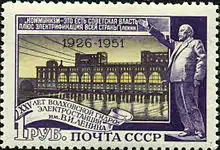
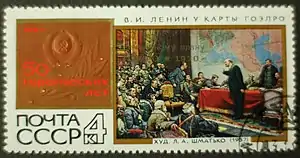
The Commission and Plan were initiated and supervised by Vladimir Lenin. Lenin's belief in the central importance of electrification to the achievement of communism is represented by his statement:[1]
Communism is Soviet power plus the electrification of the whole country.
The commission was established by the Presidium of the VSNKh on February 21, 1920,[2] in accordance with February 3, 1920, VTsIK resolution on the electrification plan development.[3] The director of the commission was Gleb Krzhizhanovsky. About 200 scientists and engineers participated, including Genrikh Graftio, Ivan Alexandrov, Mikhail Shatelen and others.[2] By the end of 1920 the Commission devised the "Russian SFSR Electrification Plan" («План электрификации Р.С.Ф.С.Р»), that was approved subsequently by the 8th All-Russian Congress of Soviets on December 22, 1920,[4] and accepted by the Sovnarkom (Soviet government) on December 21, 1921.[5]
The Plan represented a major restructuring of the Soviet economy based on total electrification of the country. Lenin's stated goal for it was "...the organization of industry on the basis of modern, advanced technology, on electrification which will provide a link between town and country, will put an end to the division between town and country, will make it possible to raise the level of culture in the countryside and to overcome, even in the most remote corners of land, backwardness, ignorance, poverty, disease, and barbarism."[6]
Foreign authors about the plan
In 1920, British writer Herbert George Wells visited Soviet Russia and met with Vladimir Lenin. Wells believed that it was impossible to realise the Russian revolutionary’s plan, as he wrote in his book Russia in the Shadows:
For Lenin, who like a good orthodox Marxist denounces all "Utopians," has succumbed at last to a Utopia, the Utopia of the electricians. He is throwing all his weight into a scheme for the development of great power stations in Russia to serve whole provinces with light, with transport, and industrial power. Two experimental districts he said had already been electrified. Can one imagine a more courageous project in a vast flat land of forests and illiterate peasants, with no water power, with no technical skill available, and with trade and industry at the last gasp? Projects for such an electrification are in process of development in Holland and they have been discussed in England, and in those densely-populated and industrially highly-developed centres one can imagine them as successful, economical, and altogether beneficial. But their application to Russia is an altogether greater strain upon the constructive imagination. I cannot see anything of the sort happening in this dark crystal of Russia, but this little man at the Kremlin can; he sees the decaying railways replaced by a new electric transport, sees new roadways spreading throughout the land, sees a new and happier Communist industrialism arising again. While I talked to him he almost persuaded me to share his vision.
"Interestingly, Herbert Well revisited the Soviet Union in 1934 and was really astonished with what he saw" - Yelena Kosheleva, Head of Mosenergo’s Museum Group, noted, when Mosenergo PLC had published a book called "GOELRO: 100 Years On", prior to the anniversary.[8]
Implementation
The GOELRO Plan was implemented during a 10- to 15-year period. According to the Plan, the territory of the Russian SFSR was divided into eight regions, with distinct development strategies due to the specific features of each region: Southern Region, Central Industrial region, Northern Region, Ural Region, Volga Region, Turkestan Region, Caucasus Region and Western Siberia Region.[3][9] The Plan included the construction of a network of 30 regional power plants, including ten large hydroelectric power plants, and numerous electric-powered large industrial enterprises.[10]
It was intended to increase the total national power output per year to 8.8 billion kWh, as compared to 1.9 billion kWh in Imperial Russia in 1913.[3] Soviet propaganda declared the plan was basically fulfilled by 1931.[3][4] While only three out of ten hydroelectric stations were built by 1930: the Volkhov, the Svir, and the Dnieper Hydroelectric Stations;[11] the goal of 8.8 billion kWh was reached in 1931,[12] and national power output continued to increase significantly. It reached 13.5 billion kWh by the end of the first five-year plan in 1932, 36 billion kWh by 1937, and 48 billion kWh by 1940.
Ivan Alexandrov later directed the Regionalisation Commission of Gosplan which divided the Soviet Union into thirteen European and eight Asiatic economic regions, using rational economic planning rather than "the vestiges of lost sovereign rights".[13]
The term "Ilyich's lamp" (лампочка Ильича) for an electric bulb, a reference to Vladimir Ilyich Lenin, is a reminder of the Plan period.
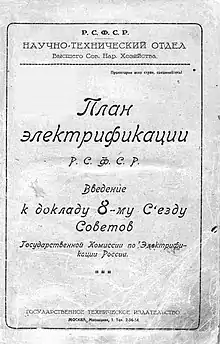 The GOELRO plan title page, 1920
The GOELRO plan title page, 1920 Poster #742 "Rosta Windows" dedicated to Russia's electrification by Vladimir Mayakovsky
Poster #742 "Rosta Windows" dedicated to Russia's electrification by Vladimir Mayakovsky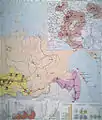 A map depicting Russia's electrification (1973)
A map depicting Russia's electrification (1973)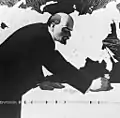 "GOELRO Plan" poster by Alexander Lemeshchenko (1967)
"GOELRO Plan" poster by Alexander Lemeshchenko (1967) The electrification of the Southern District according to the GOELRO plan
The electrification of the Southern District according to the GOELRO plan
References
- Vladimir, Lenin (1920). Our Foreign and Domestic Position and Party Tasks. Moscow.
Communism is Soviet power plus the electrification of the whole country, since industry cannot be developed without electrification.
{{cite book}}: CS1 maint: location missing publisher (link) - Neporozhnii, P. S. (1970). "50th anniversary of the Lenin Goélro Plan and Hydropower Development". Hydrotechnical Construction. 4 (12): 1089–1093. doi:10.1007/BF02397589. S2CID 110688607.
- "Great Teaching Makes Great Students", Great Quotes for Great Educators, Routledge, pp. 21–42, 2014-05-12, doi:10.4324/9781315854946-6, ISBN 978-1-315-85494-6, retrieved 2020-12-22
- (in Russian) On GOELRO Plan – at Kuzbassenergo Archived December 26, 2008, at the Wayback Machine
- "Physics in the USSR: stages in a long journey – SOV PHYS USPEKHI, 1983, 26 (8), 720–726".
- "Lenin and Lenin". International Affairs. 10 (3): 421–422. May 1931. doi:10.2307/3016220. ISSN 1468-2346. JSTOR 3016220.
- Wells, H.G. Russia in the Shadows.
- "One hundred bright years: Lighting up Moscow. Moscow Mayor official website".
- (in Russian) 85th anniversary of GOELRO plan – Management Archived 2007-09-27 at archive.today at the website of RAO UES
- Lapin, G. G. (2000). "70 Years of Gidroproekt and Hydroelectric Power in Russia". Hydrotechnical Construction. 34 (8/9): 374–379. doi:10.1023/A:1004107617449. S2CID 107814516.
- Никитин, Олег (February 2010). Плюс электрификация. Forbes (in Russian).
- Развитие электроэнергетики в СССР (к 80летию плана ГОЭЛРО) (in Russian). Archived from the original on 2018-10-22. Retrieved 2013-04-08.
- "Correction: Ekonomicheskoe razvitie gorodov belorussii V XVI-pervoi polovine XVIII V." Slavic Review. 29 (3): 569. September 1970. doi:10.2307/2493217. ISSN 0037-6779. JSTOR 2493217.
External links
- (in Russian) 85th anniversary of GOELRO plan at the website of RAO UES
- Map of the electrification from the Great Soviet Encyclopedia